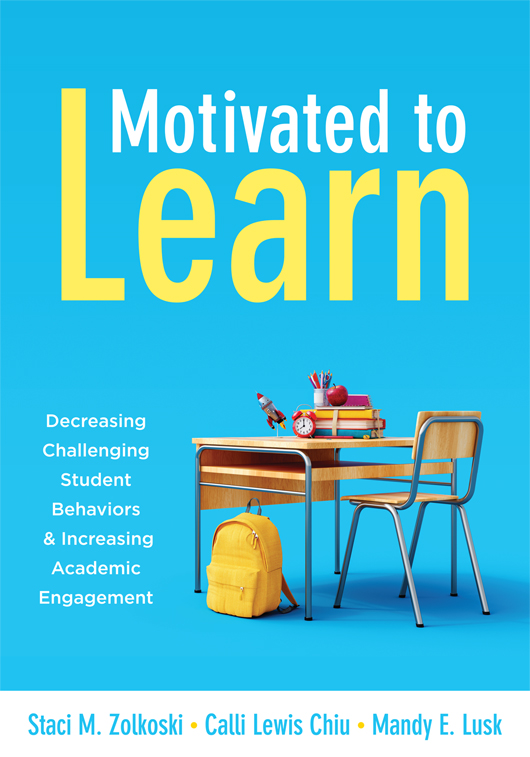Free Reproducibles
Motivated to Learn
Decreasing Challenging Student Behaviors and Increasing Academic Engagement
Create safe classrooms where students are empowered to build resilience, cope with traumatic experiences, and achieve at high levels. Learn how to cultivate a trauma-informed classroom environment and utilize classroom management strategies to encourage positive learning experiences for trauma-impacted students.
Benefits
- Understand childhood trauma and the impact traumatic experiences have on learners.
- Develop a trauma-informed attitude and mindset.
- Examine classroom structures that support trauma-sensitive practices while recognizing those that may contribute to trauma.
- Gain effective classroom management strategies and techniques to support all students, including those experiencing trauma.
- Learn how to develop trusting and positive relationships with trauma-impacted students and their families.
TABLE OF CONTENTS
Chapter 1: Why Students Exhibit Challenging Behaviors and How These Behaviors Impact Academic Engagement
Chapter 2: Students Would Like a Choice: A Guide to Providing Choices
Chapter 3: It’s All About the Reward: A Guide to Token Economies
Chapter 4: Set Students Up for Success: A Guide to High-Probability Sequencing
Chapter 5: Teamwork Makes the Dream Work: A Guide to Classwide Peer Tutoring
Chapter 6: Put the Students in Charge: A Guide to Self-Monitoring
Chapter 7: Call on Students: A Guide to Opportunities to Respond
Chapter 8: Remember What You Talked About: A Guide to Precorrection
Epilogue
Appendix: Resources for Teachers
PRINTABLE REPRODUCIBLES
Chapter 1
Chapter 2
- Figure 2.1: Event Recording
- Figure 2.2: Scatterplot Assessment
- Figure 2.3: Choice Sheet 1
- Figure 2.4: Choice Sheet 2
- Chapter 2: Questions for Reflection
Chapter 3
- Figure 3.2: Token-Economy Recording Sheet 1
- Figure 3.3: Token-Economy Recording Sheet 2
- Chapter 3: Questions for Reflection
Chapter 4
Chapter 5
- Figure 5.1: Tips to Implement Peer Tutoring
- Figure 5.2: Peer-Tutoring Tally Sheet 1
- Figure 5.3: Peer-Tutoring Tally Sheet 2
- Chapter 5: Questions for Reflection
Chapter 6
- Figure 6.1: Student Self-Monitoring Check Sheet
- Figure 6.2: Teacher-and-Student Check Sheet
- Figure 6.4: Opportunities-to-Respond Action Plan 1
- Chapter 6: Questions for Reflection
Chapter 7
Chapter 8
SUGGESTED RESOURCES
BOOKS
- Boogren, T. H. (2018). Take time for you: Self-care action plans for educators. Bloomington, IN: Solution Tree Press.
- Buffum, A., Mattos, M., & Malone, J. (2018). Taking action: A handbook for RTI at Work. Bloomington, IN: Solution Tree Press.
WEBSITES
- The National Federation of Families
- Child Welfare Information Gateway
- The Center on Positive Behavioral Interventions and Supports
- “Building (and Maintaining) Rapport in the Classroom”
- Goalbook Toolkit
- “How to Make Student Choice Work”
- Student Reinforcement Survey
- ClassDojo
- “Staying Creative With Token Economies During Behavior Modification”
- “What Is Tier 1 Support?”
- “Providing Multiple Opportunities to Respond”
- “Strategy: Increasing Opportunities to Respond”
- Google Translate
- Free Translation Online
- Kahoot!
- Body Language Around the World
- “Fundamental Skill Sheet: High-Probability Requests”
- “High Probability (High-p) Request Sequence”
- “Behavior Momentum”
- “High-Probability Requests: High School”
- The Peer Tutoring Resource Center
- “Classwide Peer Tutoring: Information for Families”
- “ClassWide Peer Tutoring”
- The Juniper Gardens Children’s Project
- “Self-Monitoring”
- “How To: Teach Students to Change Behaviors Through Self-Monitoring”
- “Step 4: Teach Self-Monitoring Procedures”
- “SOS: Helping Students Become Independent Learners” module
- “Self Monitoring”
- “4 Ways Kids Use Self-Monitoring to Learn”
- The National Center for Pyramid Model Innovations (NCPMI)
- “Strategy: Using Precorrection”
- “Pre-Correction/Prompting: Behavior”
- “Precorrection Planning Form”
- “Precorrection: Example Statements”

